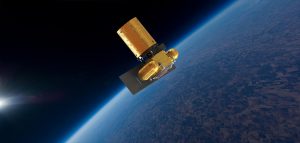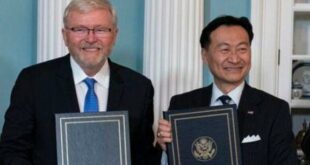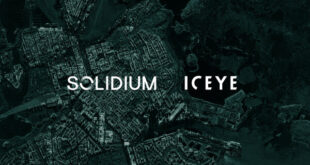
On 6 April 2020, US President Donald J. Trump signed an Executive Order (EO) on Encouraging International Support for the Recovery and Use of Space Resources. This order addresses US policy regarding the recovery and use of resources in outer space, including the Moon and other celestial bodies. Over the next few weeks, SpaceWatch.Global will publish a range of perspectives supporting and opposing the EO from experts around the world. Today’s three expert perspectives come from Professor Alice Gorman of Australia (below), Sebastien Moranta of the European Space Policy Institute (see here), and Michelle Hanlon of For All Mankind (see here).
In your opinion, what is the underlying strategic and economic rationale for President Trump’s Executive Order?
The US is already planning a major push towards a more permanent presence beyond Earth orbit with the Artemis Lunar Gateway project. This is different, though. This Executive Order sends a clear signal that the US intends to move beyond purely scientific use of lunar resources and into commercial use. Some of the resources which are immediate targets, such as the water ice at the poles, are only valuable in a local lunar/Martian economy (we’re not in need of water on Earth). The EO could be read as providing a greenlight for US commercial interests in establishing this economy.
The EO affirms the Outer Space Treaty with its clear prohibitions against appropriating territory in space, so the message here is that the US won’t try to claim the Moon as territory. However, at this point in time, it can’t get back to the Moon without international cooperation, which is the other main focus of the EO.
Strategically, the EO is a challenge to the supporters of the Moon Agreement: it pre-empts any attempt by the States Parties to convene a regulatory body to establish the principles for off-world resource use under the terms of the Agreement.
The Executive Order explicitly rejects the 1979 Moon Agreement. How do you think this will be received by other countries, particularly other major space powers?
There has been so much negative talk about the Moon Agreement, and it’s no secret that the US opposes it – so the EO is nothing new in that regard. However, it’s important to remember that the US came very close to signing it back in the 1970s. The L5 Society was a vocal opponent. They argued that the Moon Agreement gave too much power to non-spacefaring states. The change of President from Carter to Reagan was also a major factor.
People are critical of the Moon Agreement because they say it creates a situation of uncertainty, but I disagree. It’s more that space actors don’t like the obligations they may have if the Moon Agreement were the accepted model. While the OST says that the exploration and use of space must be for the benefit of all peoples, the Moon Agreement goes further in stating what the benefit should be: higher standards of living and conditions of social and economic progress for the people of Earth. It also has more detail than the OST about the sharing of scientific information. In commercial resource extraction on Earth, results are often confidential and not publicly accessible, so there is a potential conflict here. This is an issue addressed by the Vancouver Recommendations on Space Mining, which have just been released. http://outerspaceinstitute.ca/documents.html
Other critics say the Moon Agreement is problematic because the major space powers aren’t signatories, but States Parties include India, France, the Netherlands, and of course, Australia. Recent discussions in Australia have indicated clear support for the Moon Agreement from government, industry and academia. Russia has reacted strongly against the EO, but it seems other spacefaring states are biding their time.
Similarly, the Executive Order explicitly rejects the view that space is a Global Commons (note the Trump administration is not the first US administration to express this view). What, in your opinion, is the policy rationale behind this claim and, again, how do you think this will be received by other countries?
Rejecting the global commons idea so explicitly signifies a rejection of the Antarctic model, which many have held out as a good analogy for the way space could be managed. Other global commons are the atmosphere, the deep sea and cyberspace. However, there is a contradiction here – the US holds fast to the idea in the OST that space is accessible and free for all to use without discrimination, but the global commons concept underlies this. They are proposing a closure of the commons. They’re also seeing the global commons as an impediment to commercial exploitation, which it doesn’t necessarily need to be. Take the example of the air travel industry, which uses the global commons of the atmosphere.
A view you will commonly hear expressed is that ‘global commons’, ‘common province’ of humanity (from the OST) and ‘common heritage of humanity’ (from the Moon Agreement’) are vague and nebulous. It’s a choice to see them as such. Other sectors – for example the World Heritage regime – don’t have problems defining such concepts.
What the ‘common heritage’ of humanity means is that every person on Earth is a stakeholder in the Moon. The Moon has influenced the terrestrial environment, our experience of the night sky, regulated calendars, inspired art, poetry and philosophy, illuminated the human emotions of love and sadness. The rejection of the Moon Agreement could be interpreted as ruling out non-commercial and state actors as stakeholders in the future of the Moon. I think this is very concerning.
To be honest, I think other countries are going to fall over and accept the erasure of the global commons of space. This would be a mistake in my view. Once gone, we’ll never get it back.
In your view, how likely will this Executive Order “encourage international support for the public and private recovery and use of resources in outer space…?”
I can see private corporations around the world examining this to see how it can be used to their advantage. NASA called for international partners and cooperation with the Lunar Gateway, but this is explicitly about commercial enterprise. The big terrestrial mining companies were initially skeptical of space mining, but with the EO it doesn’t seem to be beyond imagination that one of them might enter into a partnership with the US to develop, say, automated polar ice extraction.
Hypothetically assuming that this Executive Order leads to international support, will it make the prospect of commercial space resource extraction closer to reality?
This is all very chicken-and-egg stuff, which is why the first generation of space mining companies have already collapsed. You need a market to justify the investment but you can’t develop that market until you have a proven product. There’s certainly a lot of unjustified optimism out there given the technical challenges of extracting and using resources on the Moon. These include operating equipment in extremely low temperatures – the Permanently Shadowed Regions where the all-important water ice is located are on average – 232 degrees C. Sunlight never penetrates these regions; there is no day. At the moment, spacecraft like the Chinese Yutu 2 rover have to power down and hibernate through the two weeks of lunar night and there’s no guarantee that they’ll wake up in working order. The sticky, abrasive lunar dust has very bad effects on machinery and humans. It was a problem for the tiny, small-scale surface operations of the six Apollo missions. Try scaling these factors up to an automated resource extraction installation and you get an idea of just how far away we are.

Associate Professor Alice Gorman, from Flinders University, is an internationally recognised leader in the field of space archaeology. Her research focuses on the archaeology and heritage of space exploration, including space junk, planetary landing sites, off-earth mining, rocket launch pads and antennas. She is a Senior Member of the American Institute of Aeronautics and Astronautics and a former Deputy Chair of the Space Industry Association of Australia. Her award-winning book Dr Space Junk vs the Universe: Archaeology and the Future was published in 2019. She tweets as @drspacejunk and blogs at Space Age Archaeology.





